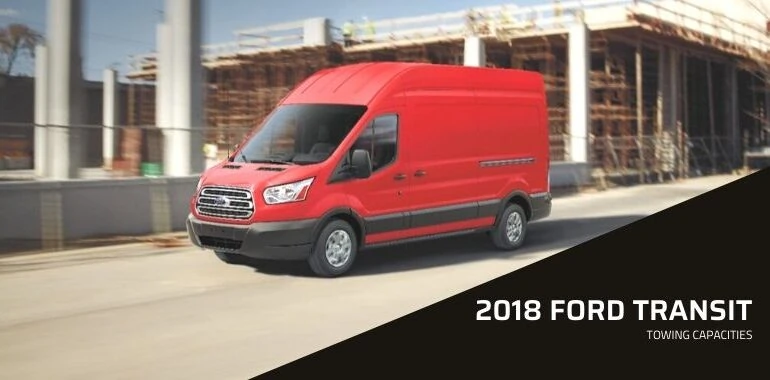Last updated on April 27th, 2022 at 08:37 pm
The 2018 Ford Transit had a pretty decent overall towing capacity they reached all the way up to 7,500 lbs. on the high-end but on the low end only had a maximum trailer weight capacity of around 3,500 lbs.
That average was for all models across the board but one thing to keep in mind is that after breaking down all of the data that some models we’re more capable than others. This article breaks down all of the variables in an easy-to-digest format that I hope will help people out there who plan on diving a little bit deeper on what the actual numbers are for these 2018 Ford Transits.
I tried to include the most relevant information for the 2018 Transit’s when it comes to towing in general but I recommend you read through your owner’s manual to get all of the information you need.
2018 Ford Transit Towing Specs Overview
* The averages that I used in this section only account for the van and wagon models. I did not include the chassis cab model’s data in the overall averages, but I did post a screenshot of the tow chart for those of you out there that are interested in that data.
What Is The 2018 Transit’s Towing Capacity?
Overall, the 2018 Ford Transit’s had an average towing capacity of 3,500-7,500 lbs. and that included all van and wagon models, but not the chassis cab models.
3.7L (V6): If you had a Transit that was equipped with the 3.7L engine, then you could expect to see a capacity range of between 4,100-6,600 lbs. The vans had the higher capacities overall, especially when paired with the 4,10 axle ratios and the passenger wagons that had the 3.7L engine option hovered around the 4,500 lb. mark.

2018 3.7l Transit Tow Chart
3.5L EcoBoost (V6): The 3.5L EcoBoost engine option that was available for some 2018 Transit models boasted a little bit higher specs than the 3.7L engine, having a capacity range of between 3,800-7,100 pounds.
Again, the van had the higher tow specs on the chart and the passenger wagons hovered around that 4,500-5,000 pound mark.

2018 3.5l Transit Tow Chart
3.2L Diesel (V8): The ’18 Transit’s that had the 3.2L diesel engine equipped saw the highest capacity ratings in the chart (up to 7,500 lbs.), but also the lowest (3,500 lbs.) so be mindful of that.
The vans that had the 3.2L engine option had a pretty decent capacity overall, especially when the 4,10 gears were used and the passenger wagons came up a little short, in my opinion, having a range of between 3,500-4,400 pounds max capacity.

2018 3.2l Transit Tow Chart
T150 Models:
The T150 models had a capacity range of between 4,500-7,500 pounds.
T250 Models:
The T250 models had a capacity range of between 4,200-7,500 pounds.
T350 Models:
The T350 models had a capacity range of between 3,500-7,400 pounds.
Van Models:
The van models had a capacity range of between 4,200-7,500 pounds.
Wagon Models:
The wagon models had a capacity range of between 3,500-5,000 pounds.
GCWR Range:
The T150 models had a capacity range of between 10,800-13,500 pounds.
The 2018 Ford Transit Towing Charts I Found…
When I looked at Ford’s 2018 Tow Guide, I found two different charts for the 2018 Transit vans and these were for the van and wagon models (one chart) and the chassis cab models (another chart). I took screenshots and posted both below that you can view for yourself.
The first chart is for the vans and wagons and the chart below that is for the chassis cab models, which I don’t think most people will be interested in but a helpful image, nonetheless.
Van/Wagon Chart

2018 Ford Transit Towing Chart
Cut Away/Chassis Cab Chart

2018 Ford Transit Chassis Cab Towing Chart
How To Read The Charts…
I wanted to include this little section in this post to describe some of the things that you will see in Fords towing chart regarding the 2018 Ford Transit. For some people it may seem like a lot of data, but it really isn’t and there are honestly only a few columns and rows that you need to be concerned with.
This section is going to explain how to read the tow charts, what certain things in the chart mean, etc.
I wanted to mention that the images used in this next section were from another model year, so do not use the tow specs in these tow charts. Instead, use the above tables.
Van VS Wagon: The top (main) columns in the table make up the two main body styles for the Transit and these are labeled “VAN” and “WAGON”, which are outlined in the example image below.
Looking at the chart, you can see that there are more choices and variables for the vans, compared to the passenger wagons and just as a quick FYI, the vans are for carrying cargo and the wagons are designed to carry passengers.
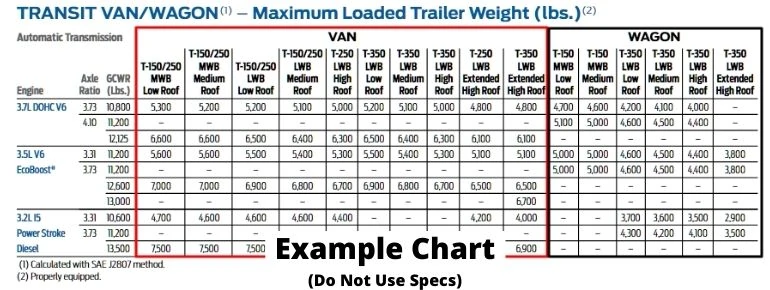
Van And Wagon Columns
T150, T250 and T350 Columns: Below the main “VAN” and “WAGON” columns you will see the model series for these vans and they are labeled as T150, T250 and T350 model series. These are similar to Ford’s trucks that use F150, F250, F350, etc. but does not directly correlate into a higher maximum trailer weight capacity range necessarily.
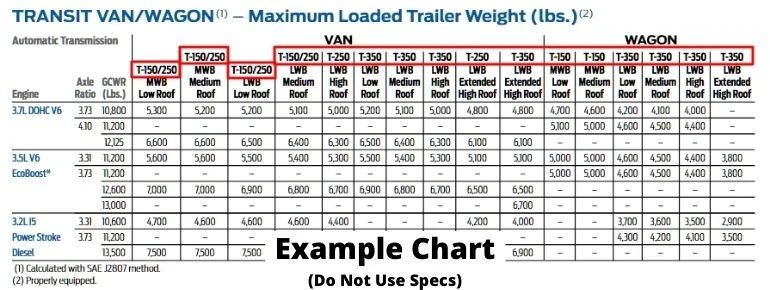
T150 T250 T350 Columns
Medium (Standard) and Long Wheelbases: Moving on down the chart, we come to the wheelbase options, of which, there are two choices. A medium (or standard) wheelbase and a long wheelbase are the two options and are abbreviated in the tables as MWB and LWB.
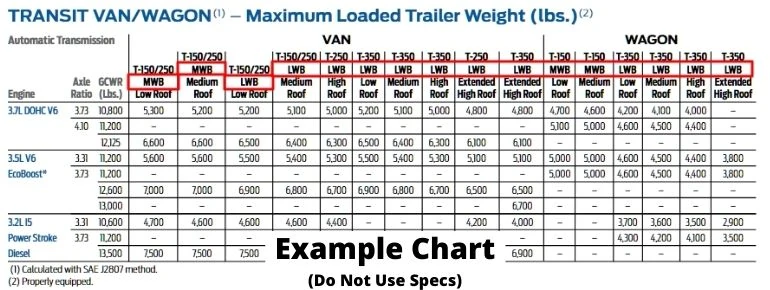
Transit Wheelbase Data
Roof Heights: There were four different roof heights for the 2018 Transit’s and these can also be found on the tow tables and are labeled as: low roof, medium roof, high roof and extended high roof.
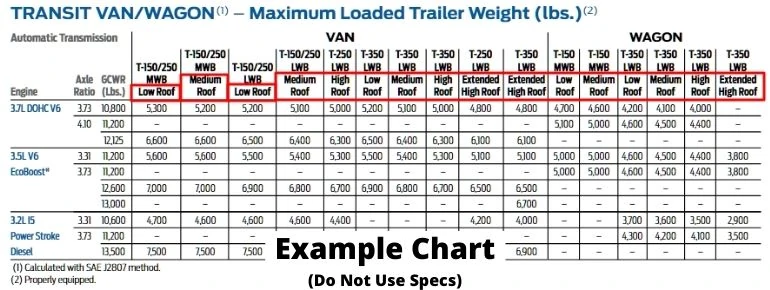
Transit Roof Heights Data
Engine Options: The main rows that make up the tables are reserved for the engine options that were available for these vehicles. In the below example, there are three different engine options to choose from, which also happens to be the same choices as the 2018 Transits.
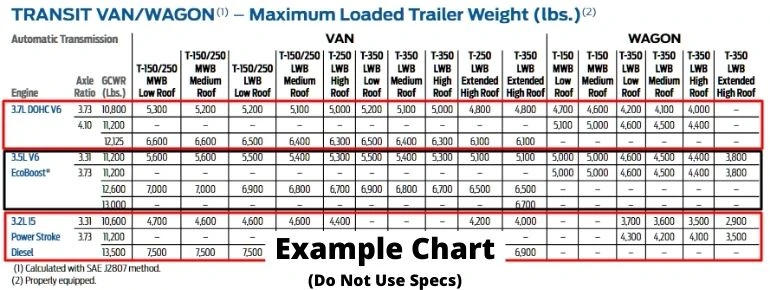
Transit Engine Rows
Axle Ratios: Axle ratios were another important metric that needed to be plugged into the tables and these are found just to the right-hand side of the engine options, and are confined inside the engine option rows because there were more than one axle ratio option for each engine.
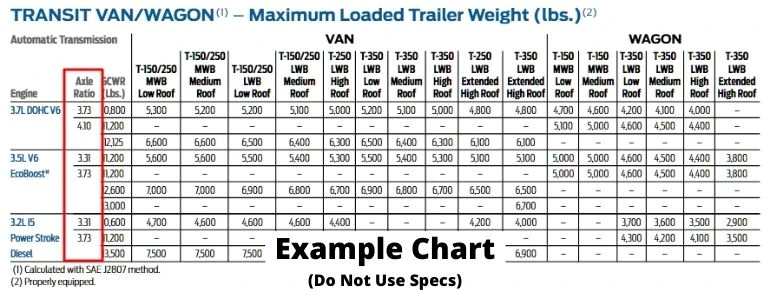
Transit Axle Ratio Column
Axle Ratios For The 2018 Ford Transits:
One essential metric you need to consider when looking at all of your tow specs on the 2018 Ford Transit charts is what axle ratio you have equipped in your vehicle so that you can see the correct maximum trailer weight capacity listed. Without the axle ratio plugged into the tables you would have no idea what you’re rating would be.
Finding out what axle ratio you have installed on your vehicle is pretty easy to figure out and can be done in a matter of minutes! The first thing you want to do is open up your driver’s side door and look around the jamb area for a sticker that looks like the one in the image below.
On this label there’s a lot of very useful information that you could use for towing, among other things and includes a lot of metrics like the gross vehicle weight rating, the gross axle ratings for both front and rear axles and the VIN number but we are looking for the axle code which is located at the bottom of the sticker and is labeled as “AXLE”.
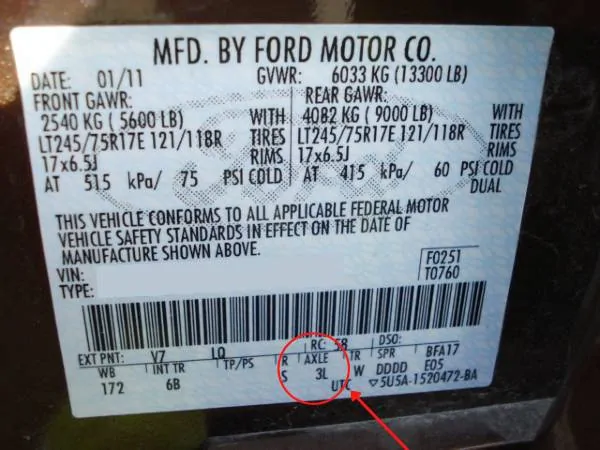
Transit Safety Certification Label Axle Ratio Area
Below this is a 2 digit figure which can consist of two numbers or a number and a letter. This is the code you need to jot down.
After you have that code, go ahead and take a look at the chart below to see what axle ratio is equipped in your vehicle by matching the corresponding axle code you found on your sticker with the axle ratio number on the left-hand column.
I also want to mention that it doesn’t matter if you have a non limited-slip axle or a limited slip axle, all you need to plug into the tow chart is the numerical axle ratio.
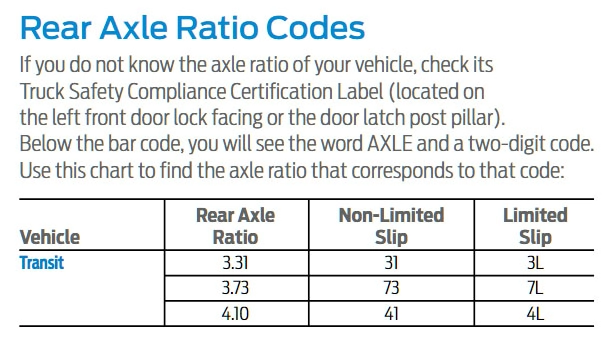
2018 Transit Axle Codes
Hitch & Tongue Weight Ratings:
I also found this hitch receiver weight capacity table in the Ford Transit Towing selector guide and wanted to post it as another visual reference. It is important to note though that these are the maximum weight limits that these specific van and passenger wagon can handle, which if you look at the towing charts is the models that have the highest towing capacity.
In other words, if your Transit wagon is only rated to haul 3800 lbs., then you would have to stick with that 3800 lb. limit. This chart it’s just showing the maximum amount of weight that’s your hitch receiver can handle.

2018 Transit Hitch Receiver Weight Capacity Limitations
Tow Packages & Options:
Like all Ford transits, the towing packages and options that are offered for these vehicles is pretty minimal and really just cover the basic equipment. Some of these basic equipment items are things like the wiring harness for your trailers electrical and includes the seven and 4 pin connectors, along with the hitch receiver of course, and a tow haul mode.
Compare that to some of the tow equipment and package options for the F-150 and you can see just how minimal and basic this equipment really is.
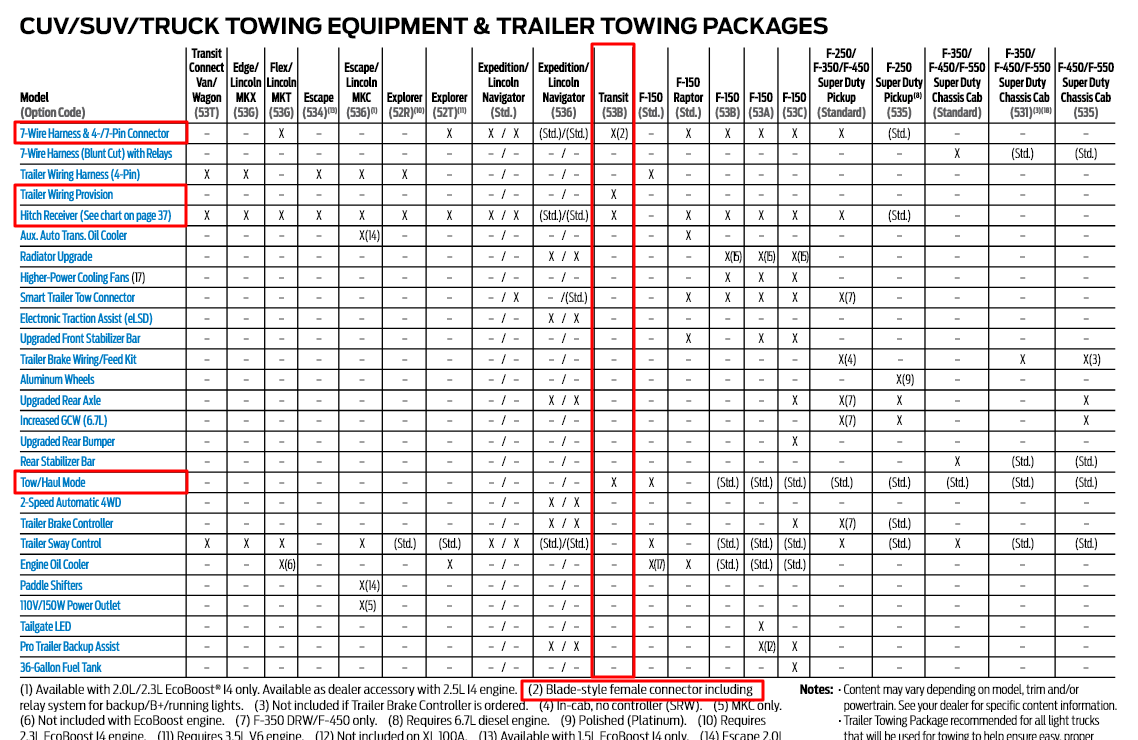
2018 Transit Tow Equipment Options
What Engine Do I Have?
There we’re only three different engine choices for the 2018 Ford transits and that makes it pretty easy to figure out which engine you have but for some people they may have no idea how to figure out what engine they have equipped in their vehicle.
Most of the time, you are able to locate some sort of identifying marker on the top of the engine if you were to open the hood and look inside the engine bay. If for some reason you are not able to find and identify and marker then you could go about finding out what engine you have equipped another way.
Find Your VIN: The first thing you will need to do is to look up your VIN. You can find your VIN in several areas in and around your vehicle but the three easiest areas to find them are on your DMV registration card, on the dashboard of your vehicle (driver’s side) or on that certification label on the inside of your driver side door jamb where the axle code was also located.
After you have your VIN, you will need to plug it into a decoder of some sort which can be found online. I like to use the decoder from driving-tests.org and is the decoder I will be using in the example below.

After you input your van into the online decoder, it will spit out a whole bunch of information on your specific vehicle and in this case I was using a VIN from a 2019 Ford Transit and as you can see under the engine column it states that the 3.7 liter engine was used on this particular vehicle.
That’s it! Now you have the engine that the manufacturer equipped and can now plug it into the tow chart to get your maximum trailer weight specifications.

Van, Wagon and Chassis Cab:
It is important to point out that there were three different body styles for the 2018 Ford transits and these were classified as: a van, a passenger wagon and a chassis cab body style.
The vans and wagons are usually the most popular choices by consumers and probably what most people are going to purchase, but the chassis cab is available as well and I think it is important to go over these body styles to better understand their differences.
Transit Van: The van body styles are really geared towards commercial clients and they are better suited for delivering goods of some sort, and is why there are no windows in the rear.
A lot of delivery services, like FedEx use these vans.
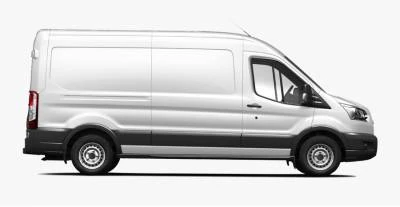
Transit Van
Transit Wagon: The wagons were made specifically to transport passengers and are usually used by the average consumer or by transportation companies to transport many people at one time.
Notice how there are many windows in the rear of the body, unlike the van body styles.
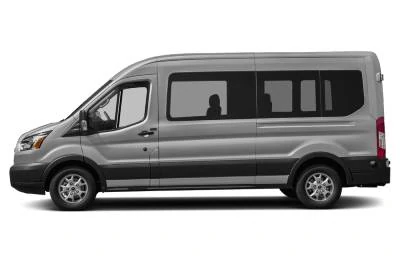
Transit Wagon
Transit Chassis Cab: The Chassis cab body style for the 2018 Ford Transit are really geared almost exclusively for commercial applications and are usually modified by adding some sort of enclosure on the back that is customized for the business.
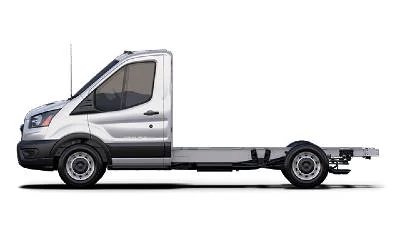
Transit Chassis Cab
Roof Heights Explained:
One thing I wanted to touch on really quick was the different roof heights that we saw on the tow charts. I was looking around through the trailer towing selection guide (that I have linked to below) and found these two charts that specify the passenger wagon and van roof height specs.

2018 Transit Wagon Roof Height Specs

2018 Transit Van Roof Height Specs

Transit Roof Height Options (Ext. High Roof Not Shown)
Additional Safety Notes I Found:
Although most of the information found in this article was gathered from the 2018 Ford Towing guide, there was other tow related information I found in the owner’s manual, as well
I went ahead and took a couple of screenshots of some of the other information I was able to find in the owner’s manual, so you can get an idea of what kind of information was actually in there.
On a side note, this was not all of the info I found in the owner’s manual and was only a small portion of what was actually in there, so be sure you read the manual yourself to get familiar with your vehicle.
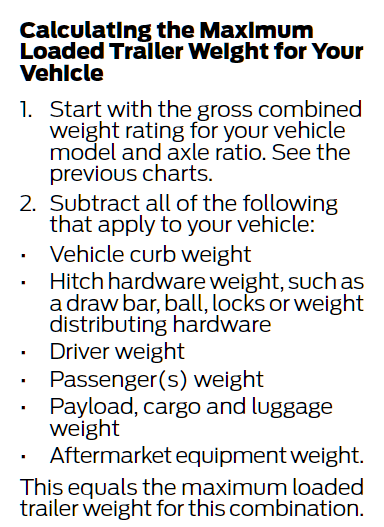
Ford Transit Trailer Weight Calculation
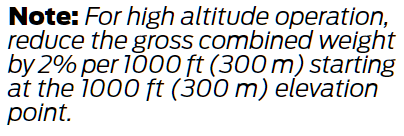
Ford Transit High Altitude Weight Compensation Notice
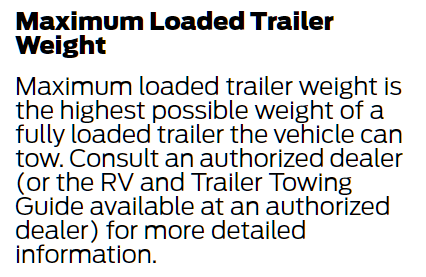
Ford’s Maximum Loaded Trailer Weight Definition 1
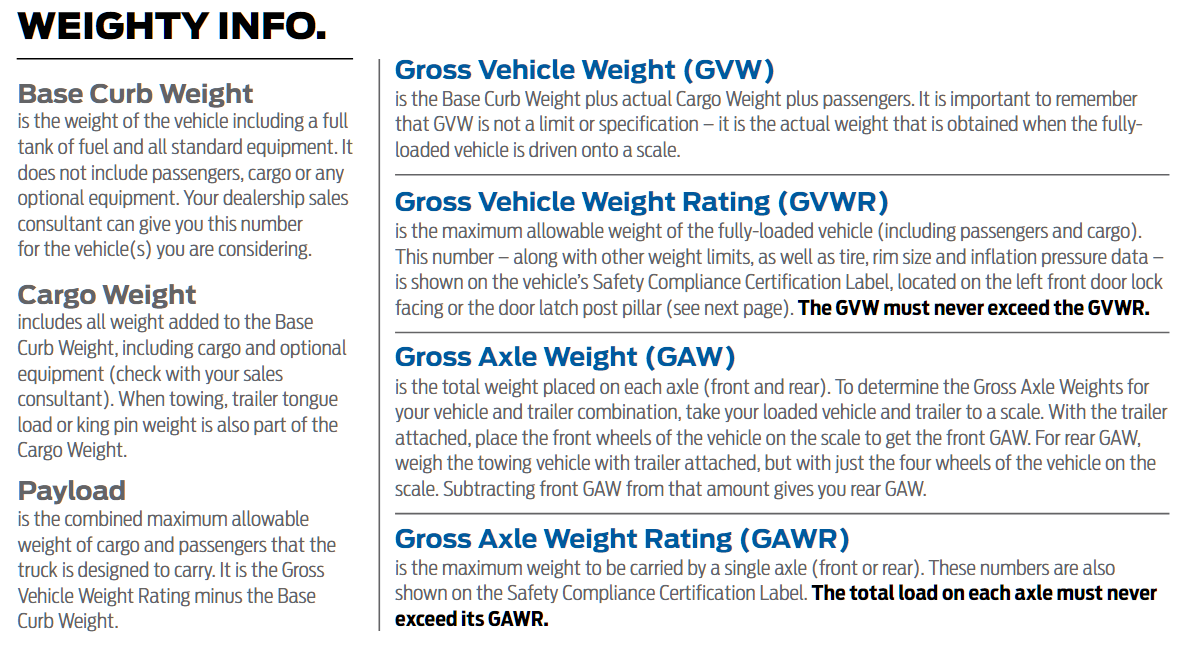
Ford’s Weight Definitions
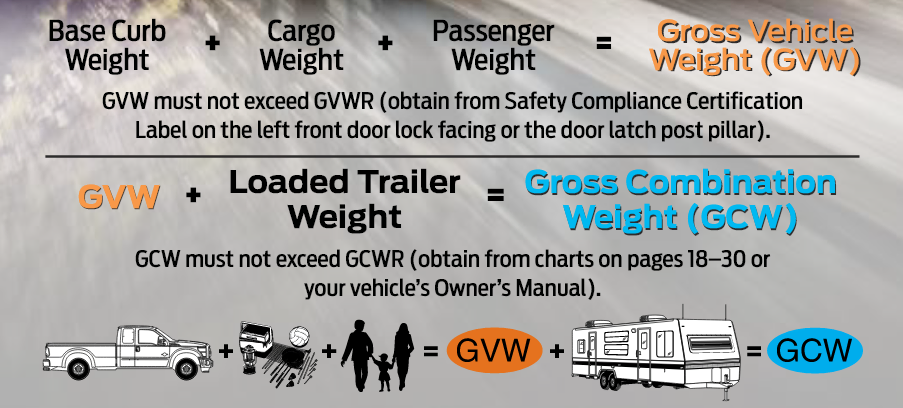
Ford’s 2017 GVW And GCWR Infographic
A Few Helpful Links For Your Reference:
I where was able to find all of the resources for the 2018 Ford transits online and used four different resources in total to gather all of my information for this article.
I have listed all of the resources I found below and most of them came directly from Ford’s website except for the Ford Transit brochure, which did come from a third party source, but it is a reputable website that usually lists many different car manufacturers Publications on a pretty regular basis.
